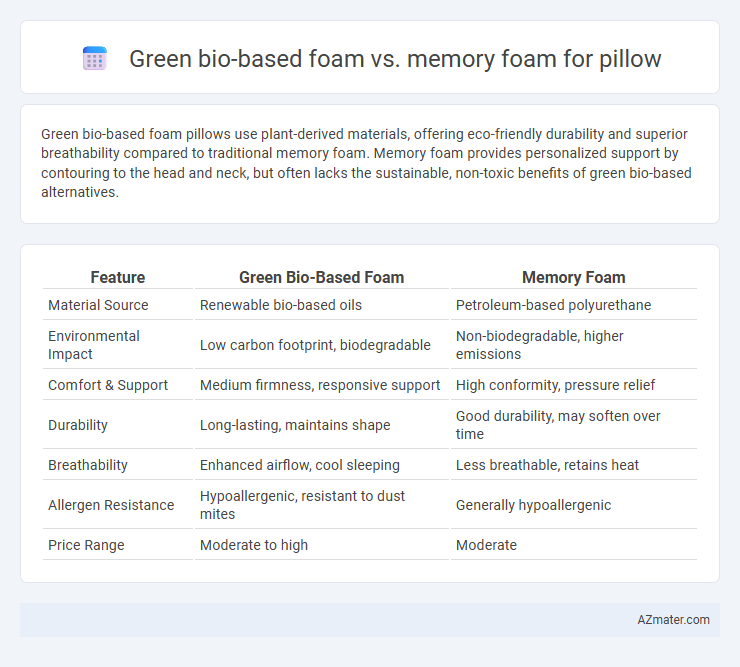Green bio-based foam pillows use plant-derived materials, offering eco-friendly durability and superior breathability compared to traditional memory foam. Memory foam provides personalized support by contouring to the head and neck, but often lacks the sustainable, non-toxic benefits of green bio-based alternatives.
Table of Comparison
| Feature | Green Bio-Based Foam | Memory Foam |
|---|---|---|
| Material Source | Renewable bio-based oils | Petroleum-based polyurethane |
| Environmental Impact | Low carbon footprint, biodegradable | Non-biodegradable, higher emissions |
| Comfort & Support | Medium firmness, responsive support | High conformity, pressure relief |
| Durability | Long-lasting, maintains shape | Good durability, may soften over time |
| Breathability | Enhanced airflow, cool sleeping | Less breathable, retains heat |
| Allergen Resistance | Hypoallergenic, resistant to dust mites | Generally hypoallergenic |
| Price Range | Moderate to high | Moderate |
Introduction to Green Bio-Based Foam and Memory Foam Pillows
Green bio-based foam pillows are made from renewable plant materials such as soy or castor oil, offering an eco-friendly alternative to traditional foams with improved breathability and natural antimicrobial properties. Memory foam pillows, crafted from viscoelastic polyurethane, provide superior contouring support and pressure relief by conforming closely to the head and neck shape. Both types balance comfort and durability, but green bio-based foam emphasizes sustainability and reduced environmental impact while memory foam focuses on ergonomic support and pain reduction benefits.
What is Green Bio-Based Foam?
Green bio-based foam is an eco-friendly pillow material derived from renewable resources such as plant oils, offering biodegradability and reduced carbon footprint compared to traditional memory foam made from petroleum-based polyurethanes. This sustainable foam often incorporates natural components like soy or castor oil, enhancing breathability and thermal regulation while maintaining supportive comfort. Its production minimizes harmful chemical emissions, making it a preferred choice for environmentally conscious consumers seeking green alternatives in bedding.
Understanding Memory Foam: Features and Composition
Memory foam pillow features viscoelastic polyurethane foam known for its high density and slow response to pressure, providing excellent contouring and pressure relief. Its composition includes open-cell structures infused with viscoelastic chemicals that enable heat sensitivity, allowing the foam to soften and mold according to body heat and weight. This unique combination enhances spinal alignment and reduces pressure points, making memory foam a popular choice for ergonomic pillow design.
Sustainability and Environmental Impact
Green bio-based foam pillows significantly reduce environmental impact by utilizing renewable plant-derived materials, which decrease reliance on petroleum-based products and lower carbon emissions during production. In contrast, traditional memory foam relies heavily on petroleum, generating higher greenhouse gases and contributing to non-biodegradable waste in landfills. Choosing green bio-based foam supports sustainable resource use and enhances biodegradability, aligning with eco-friendly practices and reducing overall ecological footprint.
Comfort and Support Comparison
Green bio-based foam pillows provide enhanced breathability and superior moisture-wicking properties, promoting a cooler sleep environment compared to memory foam. Memory foam excels in contouring closely to the head and neck, offering exceptional pressure relief and support for spinal alignment. While green bio-based foam balances comfort with eco-friendly benefits, memory foam remains preferred for targeted support and durability in pillows.
Breathability and Temperature Regulation
Green bio-based foam pillows offer superior breathability due to their open-cell structure that enhances airflow, effectively reducing heat retention during sleep. Memory foam pillows often trap heat because of their dense composition, leading to less efficient temperature regulation and increased discomfort. The natural materials in green bio-based foams promote moisture wicking and cooling, making them ideal for maintaining a comfortable sleeping temperature.
Allergens and Health Considerations
Green bio-based foam is often free from harmful chemicals such as volatile organic compounds (VOCs) and formaldehyde, reducing allergen exposure and promoting better indoor air quality for sensitive individuals. Memory foam, while providing excellent support, may off-gas chemicals that can trigger allergies or asthma in some users. Choosing green bio-based foam pillows can minimize respiratory irritation and skin sensitivities, enhancing overall health and sleep comfort.
Durability and Longevity
Green bio-based foam pillows offer superior durability due to their natural plant-based materials, resisting degradation and maintaining structural integrity longer under regular use. Memory foam pillows, while providing excellent initial support and contouring, tend to compress and lose resilience over time, typically lasting 2 to 3 years before needing replacement. The sustainable composition of green bio-based foam contributes to enhanced longevity, making it a more durable choice for eco-conscious consumers.
Price and Accessibility
Green bio-based foam pillows are often priced higher than traditional memory foam due to sustainable materials and eco-friendly production processes, making them less accessible in some markets. Memory foam pillows dominate the market with a wide range of prices and broad availability in major retail stores and online platforms. Consumers prioritizing affordability and easy access typically find memory foam options more convenient, while those valuing environmental sustainability may invest in green bio-based alternatives despite the premium cost.
Choosing the Best Pillow: Green Bio-Based vs Memory Foam
Green bio-based foam pillows offer eco-friendly benefits by utilizing renewable plant materials, providing breathability and natural hypoallergenic properties. Memory foam pillows excel in contouring support, relieving pressure points with their viscoelastic material, but can retain heat and contain synthetic chemicals. Choosing the best pillow depends on prioritizing sustainability and airflow with green bio-based foam or superior ergonomic support and durability with memory foam.

Infographic: Green bio-based foam vs Memory foam for Pillow
 azmater.com
azmater.com